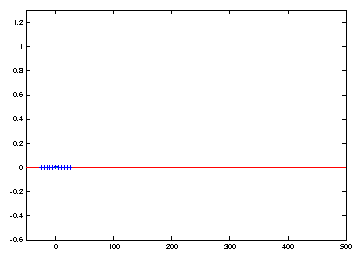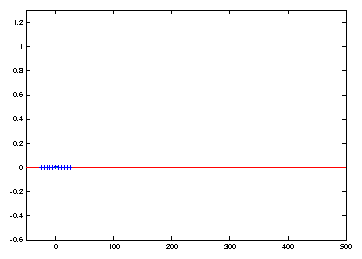The propagation errors in the wavespeed with the fixed frame of reference
resulted when the spatial step size ![]() was too large. For the moving frame of reference, these errors
are less significant, but only because smaller step sizes can be taken, e.g.,
was too large. For the moving frame of reference, these errors
are less significant, but only because smaller step sizes can be taken, e.g.,
![]() is 8 times smaller in the simulation of Figure 2
compared to that of Figure 1.
is 8 times smaller in the simulation of Figure 2
compared to that of Figure 1.
In fact, the addition of the advection term
![]() for moving frame of reference can result
in stability problems under spatial discretization if the step size
for moving frame of reference can result
in stability problems under spatial discretization if the step size ![]() is too large. To illustrate this difficulty, consider the moving
computational domain
is too large. To illustrate this difficulty, consider the moving
computational domain
![]() with only N=10 nodes. The
uniformly spaced moving mesh
with only N=10 nodes. The
uniformly spaced moving mesh

|
Numerical discretization with method of lines and Hermite collocation leads
to oscillatory behaviour near u=0, which can be seen at t=180
in Figure 3. For the case of
the Nagumo equation, this oscillation changes the asymptotic behaviour from
a monotone decreasing wavefront of speed c0=4/3to a monotone
increasing wavefront of speed c0=4/3 for ![]() . This simulation suggests that it is more important to suppress
oscillations near unstable equilibria (such as u=0) where even a small
perturbation caused by discretization can lead to an entirely different final
asymptotic state.
. This simulation suggests that it is more important to suppress
oscillations near unstable equilibria (such as u=0) where even a small
perturbation caused by discretization can lead to an entirely different final
asymptotic state.
If the method of lines Hermite collocation discretization scheme is applied
on a non-uniform mesh where ![]() is sufficiently small in ``unstable'' regions where
is sufficiently small in ``unstable'' regions where
![]() then oscillations at the advancing wavefront can be
suppressed. Rather than define a non-uniform mesh in advance, we apply the MOVCOL
adaptive moving mesh algorithm, and supply a monitor function
then oscillations at the advancing wavefront can be
suppressed. Rather than define a non-uniform mesh in advance, we apply the MOVCOL
adaptive moving mesh algorithm, and supply a monitor function
![\begin{align*}M(u,u_{x}) = \sqrt{ \kappa_2 e^{\kappa_1 f^{\prime}(u)} +
\biggl[ 25 \frac{\partial u}{\partial x} \biggr]^2}
\end{align*}](img99.gif)
where ![]() are weighting parameters to control the mesh spacing.
In the following Nagumo simulation, we set
are weighting parameters to control the mesh spacing.
In the following Nagumo simulation, we set ![]() and
and
![]() so that
so that
![]() and
and
![]() i.e., the monitor function
will place more points in regions where
i.e., the monitor function
will place more points in regions where ![]() or where
or where ![]() is large.
is large.
In Figure 4 we see numerical evidence that the oscillations have been suppressed. With only N=10nodes, there is still propagation error, with the discretization moving at a faster speed.

|